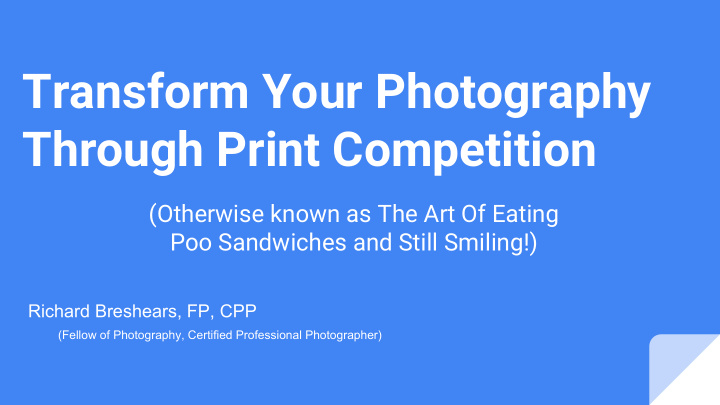



Transform Your Photography Through Print Competition (Otherwise known as The Art Of Eating Poo Sandwiches and Still Smiling!) Richard Breshears, FP, CPP (Fellow of Photography, Certified Professional Photographer)
Why do print competition?? Why NOT!!???? ● Print Competition is good for building your skills, chops, hair, calluses ○ Print judging is “subjective”. Isn’t all art? “It stifles my creativity.” ○ “It costs lots of money.” ○ ○ “I can’t stand having someone call my baby ugly.” ○ “Preparing images takes lots of time.” “I only do this for fun. I don’t need all that stress.” ○
So....Now That Rich Has Convinced me to do print competition...My next steps are? 1. Submit some prints locally. (Look Behind You!!) 2. Join or create a group of like-minded photographers who want to compete and help each other out. 3. Get signed up for the next 4Cs print competition. 4. Join PPW or PPA and do their competitions. 5. Go to www.printcompetition.com and watch the competitions. 6. Go to www.psa-photo.org and watch competitions and results. 7. Go to www.8feetacross.com get critiqued by trained pros. 8. Spend a lot of time drawing, researching, and looking at great images/art
Understanding how prints are judged: “Once you find the key you can unlock the door” - Gary Meek CPP, Cr, A-ASP, EA-ASP, M-Photog, FP, ... Prints are NOT judged strictly by subjective measure. In all cases, locally and internationally, prints are judged by a set of objective standards. Those standards are trained in the judges to varying levels of success. The more training and experience a judge receives the better they become at looking through their own subjectiveness at the objective parts of the image. However, the judges are still HUMAN!
Professional Photographers of America’s 12 elements of a Merit Image The 100 point scale system 1. Impact 7. Color Balance 2. Technical 8. Center of Interest 3. Creativity 9. Lighting 4. Style 10. Subject Matter 5. Composition 11. Technique 6. Presentation 12. Story Telling All images have some amount of each of these. Think of the best image you’ve ever seen and start at a score of 100. In evaluating each image subtract points in areas where that best image could improve. Your score comes from that equation.
The f5.3 method www.8feetacross.com Each image is graded on three areas: 1. Composition 2. Technical Skill 3. Impact Each of those areas gets up to 5 points. A perfect image receives a rare #15. Along with each of these areas there is an explanation of what is good and what needs improvement.
Ken Whitmire Method The 20X5 method Impact = 20 Lighting = 20 Composition = 20 Technical Quality = 20 Presentation = 20 _____________________________ 100
Impact ● Concept or Idea ● Story Telling Interest ● Attracts the eye and impresses the viewer ● ● Reason for Being
Lighting ● Exposure Levels ● Lighting Ratios Highlight and Shadow ● Direction of Light - “Modeling” ● ● “Kicker” - Impact, etc...
Composition ● Space ● Positioning Line and Form ● Tonal Value (Relationships) ● ● Line and Form Subjects, Background Items - Relationships
Presentation ● Finishing ● Cropping Shape ● Borders ● ● Etc...
Now that you’re trained… Let’s Judge Some Images!!! My personal rules 1st! 1. Be NICE!!!!! I have really thick skin. I know I shoot crap and have had the hardest judges in the world beat on me so nothing you say will hurt. However, this needs to be a safe place for all of you. 2. Say something you like BEFORE you say something that needs correction. 3. Give a Score! In baseball it’s a ball, a strike, or a foul. Don’t cheat the person by not giving them a score. 4. Be NICE!!! (You’ve been warned!)
Recommend
More recommend